Carrots are among the easiest garden vegetables to grow—and the most bountiful–given the right conditions.
Carrot culture is very simple. Sow the seeds rather thickly and thin the plants to 3 to 4 inches apart. If the soil is nutrient-rich and loose, there will be no trouble with root development. Remember, young, tender, quick-growing carrots are better flavored than old or slow-growing carrots.
Grow carrots in the cool time of the year—spring and autumn. To grow carrots with straight roots, plant in loose soil free of pebbles, stones, or other obstructions. For a continuous harvest, sow carrots in succession every two weeks up until mid-summer. Later sowings may not mature before frost.
Related articles:
- Seven Ways to Cook and Serve Carrots
- Glazed Carrots Simply Made
- Carrot Seed Starting Tips
- How to Harvest and Store Carrots
- Carrot Growing Problems Troubleshooting
- Grow Carrots Any Time of the Year in Five Steps

Carrots quick growing tips
- Sow carrots in the garden 2 to 3 weeks before the average last frost date in spring for harvest before the onset of summer heat.
- Sow carrots again in mid to late summer as late as 12 weeks before the first fall frost for autumn harvest.
- In cool summer regions, sow succession crops from spring to autumn every 2 to 3 weeks until about 12 weeks before the date of the average first frost.
- Where summers are hot and winters are mild, grow carrots in autumn, winter, and early spring.
- Carrots require from 50 to 80 days to reach maturity; baby carrots can be harvested in about 30 days.
- Grow carrots in loose soil free of stone and obstacles; this will allow the roots to grow straight and unimpeded. Roots will fork if they hit an obstacle.
- Grow carrots in soil rich in organic matter; feed carrot beds with aged compost. Avoid nitrogen-rich fertilizers; too much nitrogen can cause carrot roots to fork. Compost is rich in phosphorus and potassium which help keep roots from becoming hard and woody.
- Thin seedlings early and give roots room to grow; unnaturally short roots can result from overcrowding.
- Keep the soil moisture even; splitting roots is caused by too much water followed by a dry spell.
- Keep root tops covered with soil to avoid green shoulders and bitter flavor.
Tools for Vegetable Gardeners at Amazon:
- A.M. Leonard Straight Rake with Ash Handle
- All-Steel Nursery Spade with D-Grip Handle
- 4-Tine Spading Digging Fork with D-Handle
- Digital Soil pH Meter Outdoors Greenhouse
- Earthwise Handheld Electric Fertilizer Spreader
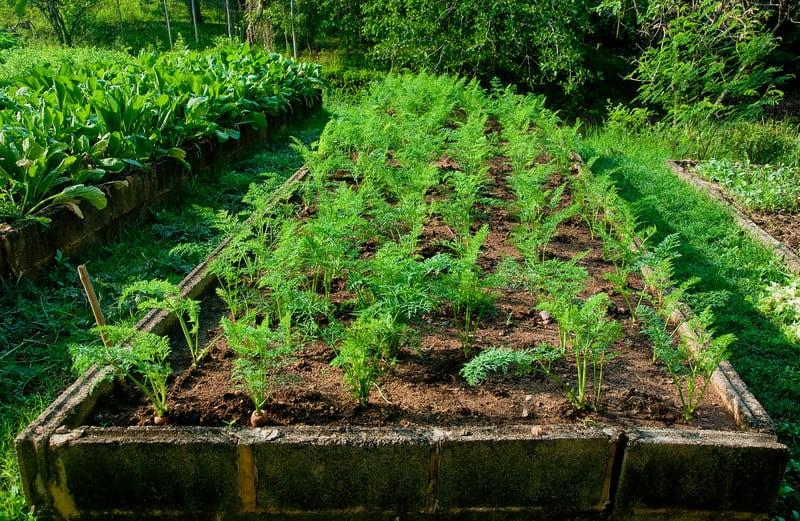
Types of carrots
There are dozens and dozens of carrot varieties and cultivars. Varieties and cultivars are commonly grouped by growth habit and appearance. Here are root descriptors and their common group name:
- Long and slender–Gold Pak
- Long, slender, broad shoulders — Imperator
- Medium slender, tapering — Danvers
- Medium plump, blunt end — Spartan
- Medium plump, tapering — Chantenay
- Medium cylindrical, blunt tip — Nantes
- Round
- Small
- Unusual colors (white, purple, yellow, red — not orange carrots)
Carrot varieties by type
- Short (2 to 4 inches): ‘Bolero’ (73 days); ‘Minipak’ (60-65 days); ‘Tiny Sweet’ (60-65 days).
- Half-long (5 to 6 inches): ‘Danvers Half-long’ (75 days); ‘Gold King’ (70 days); ‘Royal Chantenay’ (70 days).
- Cylindrical (6 to 7 inches): ‘Nantes Coreless’ (68 days); ‘Royal Cross Hybrid’ (70 days); ‘Tuchon Pioneer’ (75 days).
- Standard (7 to 9 inches): ‘Gold Pak’ (75 days); ‘Imperator carrots’ (75 days); ‘Spartan Bonus’ (77 days); ‘Tendersweet’ (75 days).
- Multicolored carrots: not all carrots are orange. Carrot color can vary: wild carrots and hybrid varieties can have white, purple, yellow, and red–as well as bright orange root. Seed growers offer multicolor blends.
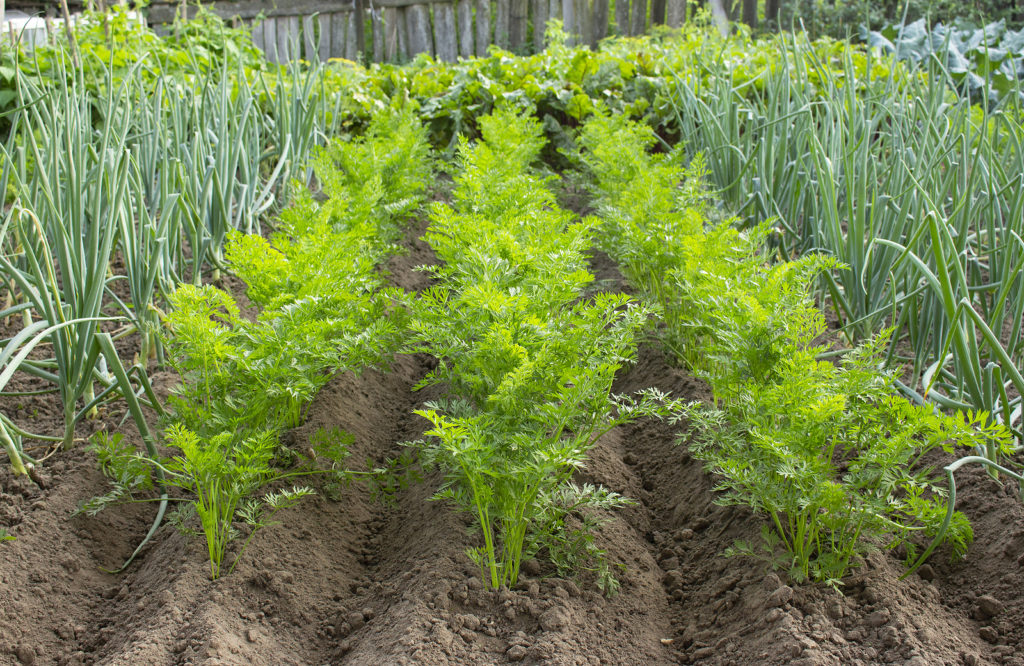
Where to plant carrots
Carrots grow best in dry, light soil rich in well-rotted compost or manure added a month or two before planting. Grow carrots in soil free from debris, pebbles, and rocks to avoid forking or constricted growth. Start carrots in spring or grow year-round in successive planting in mild winter regions.
- Grow carrots in a sunny location; carrots will grow slowly in partial shade. Six to eight hours of sunlight is best for healthy growth.
- Plant carrots in deep, loose, well-worked, and well-drained soil. Add several inches of aged compost or commercial organic planting mix to the planting beds before planting. Turn the soil to 12 inches (30cm) or more. Soil rich in organic matter is best for growing carrots.
- Soil preparation is important for growing carrots. Remove clods, rocks, and solid objects from planting beds before sowing seed; carrots will split, fork, and become malformed if their roots grow into obstructions.
- Work rock phosphate or wood ashes into the soil before planting to ensure fertility
- Carrots prefer a soil pH of 5.5 to 6.8.
- If you have rocky soil or heavy clay, grow carrots in a raised bed. Planting in raised or mounded beds are ideal for growing carrots.
Carrots planting time
Sow carrot seeds in spring 3 weeks before the last expected frost and every 2 weeks after that. For the autumn harvest, sow seed about 10 weeks before the first hard frost is expected. Carrots started in autumn can be protected from winter cold by a thick layer of straw or compost and then harvested in early spring. Carrots that mature in the summer heat are usually bitter tasting. Protect seed and young seedlings from drying temperatures by covering the planting bed with a floating row cover. Thin seedlings 1 to 2 inches apart once they are about 3 inches tall.
- Carrots are a cool-season crop best grown in spring, early summer, and autumn.
- Carrots require a soil temperature of about 45°to 85F° (7-29C°) to germinate; germination will be slow in cold soil.
- Carrots grow best at an average temperature of 60° to 65° (15-18C°).
- Where temperatures do not get hot in summer, sow carrots in the garden every 2 to 3 weeks for a continuous supply.
- It is not worth the effort to grow carrots in very warm soil or weather; success will be limited and flavor will be compromised. Carrots are most flavorful when grown in cool weather and soil.
- Where summers are hot and winters are mild grow carrots from autumn to early spring.
Carrot crop rotation
- Carrots do well when planted after beans and other legumes. The extra nitrogen set by legumes will give carrots a boost.
- Amend the soil when planting carrots after heavy feeders such as peppers.
- If you leave a few carrots in the ground over winter, the flowers they produce in the second season will attract beneficial insects to the garden.
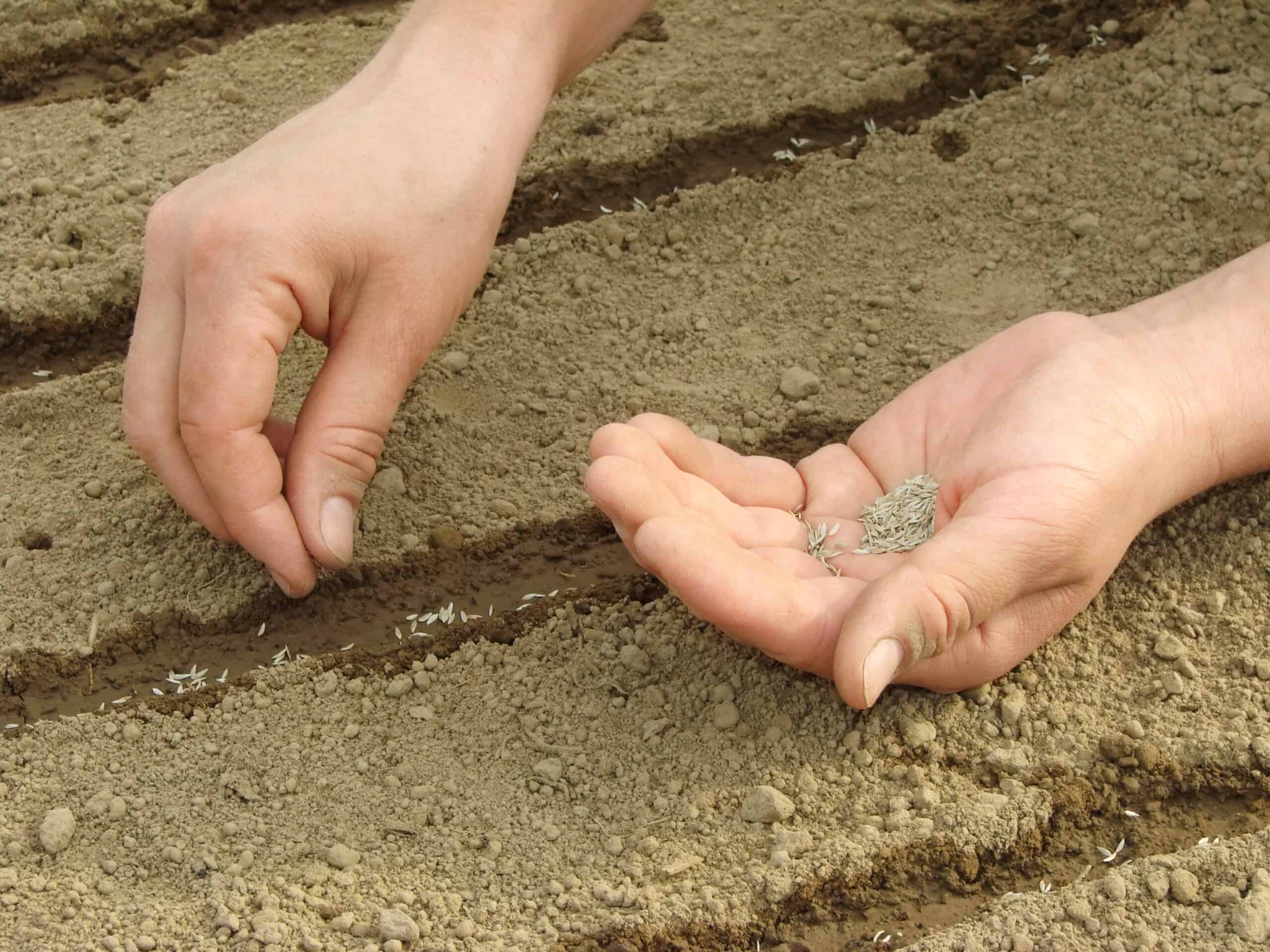
Planting and spacing carrots
Grow carrots in well-worked, light soil free of pebbles and rocks. Grow carrots in raised or mounded beds when native soil is heavy with clay. Keep the garden free of weeds which will compete with carrots for nutrients and moisture. Don’t grow carrots where you grew potatoes, beets, parsnips, celery, eggplants, tomatoes, or peppers the year before.
- It is best to plant directly in the garden where they will grow. Carrots started in small pots or trays can be difficult to transplant; root damage at transplanting time can cause carrots to be stunted.
- Sow carrot seeds ¼ to ½ inch deep about 1 inch (2.5cm) apart; in warm, dry weather, sow carrot seeds deeper than ½ inch.
- Germination will occur in 14 to 21 days; keep the seedbed just moist until germination.
- Soil crusting will slow germination. To prevent crusting cover the seed with vermiculite or finely ground aged compost instead of garden soil.
- Soak the seed in warm water overnight or for several hours before sowing; this will speed germination.
- Thin carrots to about 4 inches (10cm) apart in all directions in wide beds; space plants about 3 inches (7.6cm) apart in rows.
- If sowing tiny carrot seeds to too difficult, get carrot seed tape at the garden center. Seeds are embedded in biodegradable tape at the right distance. Carrot seedlings will not need thinning when the seed tape is used.
- Overplanting seeds will require extensive thinning.
- Space carrot rows 12 to 24 inches (30-61cm) apart in the home garden.
- Wide-row planting of carrots gives a good yield from a small area.
- Plant 30 carrots per household member.
More tips: Carrot Seed Starting Tips.
Quick sprouting carrot seeds: How to Pre-Sprout Carrot Seeds
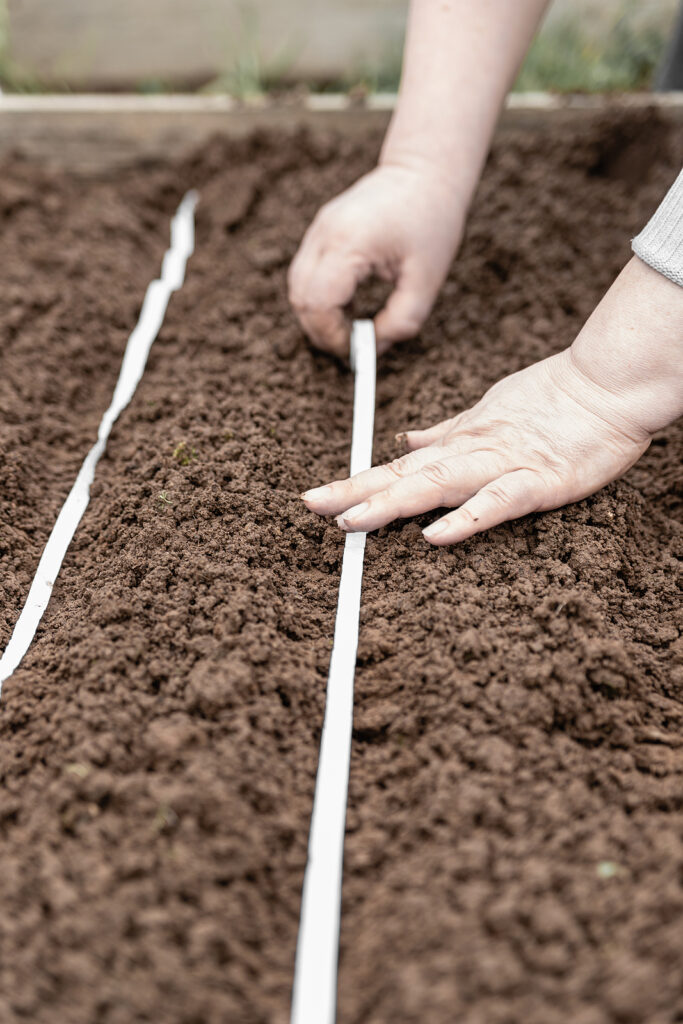
Carrot companion plants
- Plant carrots with chives, onions, leeks, tomatoes, peas, and rosemary.
- Avoid planting carrots with dill.
Watering carrots
- Keep carrots evenly moist to ensure quick growth. When the soil surface goes dry, stick your index finger into the soil; if it comes away dry, it is time to water.
- Do not allow the soil to dry out.
- Reduce watering as roots approach maturity; too much soil moisture at the end of the growing time will cause roots to crack.
- An inch of water (6.5 gallons per square foot) weekly is best in hot weather. Growing carrots in light soil–sandy soil–will require additional water. Sandier soil is best amended with organic matter that will hold soil moisture near the roots.
- If you grow carrots where heavy rain is common, it is best to plant carrots in a raised or mounded bed. Even good soil can be too wet for carrots in rainy regions.
Feeding carrots
- Add aged compost to planting before sowing and again as a side dressing at midseason.
- Before planting, spread wood ash over planting beds to provide extra potassium for root growth.
- Carrots will benefit from applications of compost tea from emergence until the green tops are 5 to 8 inches tall. Apply 1 cup per foot of row every 10 to 14 days.
- Feeding carrots too much nitrogen will result in hairy roots.
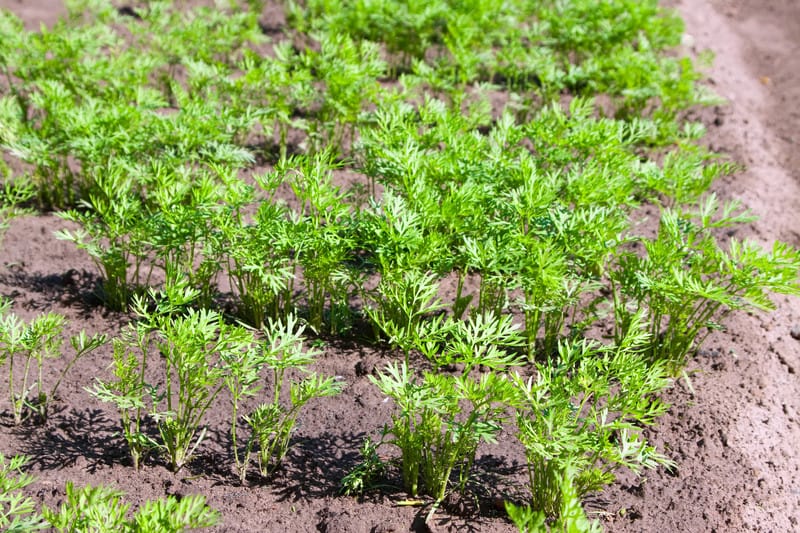
Caring for carrots
- Thinning carrots is very important. Thin carrots in two stages: (1) when seedlings are about 2 inches tall and true leaves have appeared, thin plants to stand 2 inches apart in rows; snip off weak plants at the crown; do not disturb the roots of plants that remain; (2) at midseason, thin again; pull up some baby carrots leaving equal space between carrots that will remain to grow on to full size.
- Weed control is important for growing carrots. Keep planting beds well-weeded. Shallow cultivation is necessary to avoid damaging carrot roots. Carrots cannot compete with weeds.
- Mulch carrot beds to keep soil temperature and moisture even. Even moisture throughout the growing season is important for quick root growth.
- Mulch with aged compost across the tops of carrots to prevent green shoulders—that is chlorophyll discoloration of root shoulders–which will leave a bitter taste.
Growing tips: Growing Carrots for Flavor.
Container growing carrots
- Standard and large carrot varieties are not a good choice for containers, but short or finger varieties will grow easily in containers.
- Half-long varieties can be grown in deep containers.
- Use a potting mix recommended for vegetables or a soil mix rich in organic matter.
- Plant carrots in wide rows in square or rectangular containers, or in concentric circles in a round container.
Carrot pests
- Carrots usually have no serious insect pest problems. Occasionally aphids, carrot rust flies, leaf hoppers, carrot weevils, wireworms, and cutworms can pose a problem to carrots and other root crops.
- Aphids, carrot rust flies, and carrot weevils can be excluded by using a floating row cover as a barrier.
- Many pests can be avoided by early planting of the carrot crop.
- Beneficial insects such as ladybugs and lacewings can keep pest insects at bay in the veggie garden.
Carrot diseases
- Leaf blight and root-knot nematodes may occasionally attack carrots.
- Leaf blight and leaf spot are fungal diseases that may cause serious damage to bunching carrots by disfiguring foliage.
- Root rots can cause serious damage in storage. Low temperatures and layers of carrots alternated with layers of straw to absorb excess moisture will slow or hinder decay in storage.
- A crop rotation plan will help protect carrots from soil-borne plant diseases. Check seed packets for disease resistance.
When problems occur: Carrot Growing Problems: Troubleshooting.
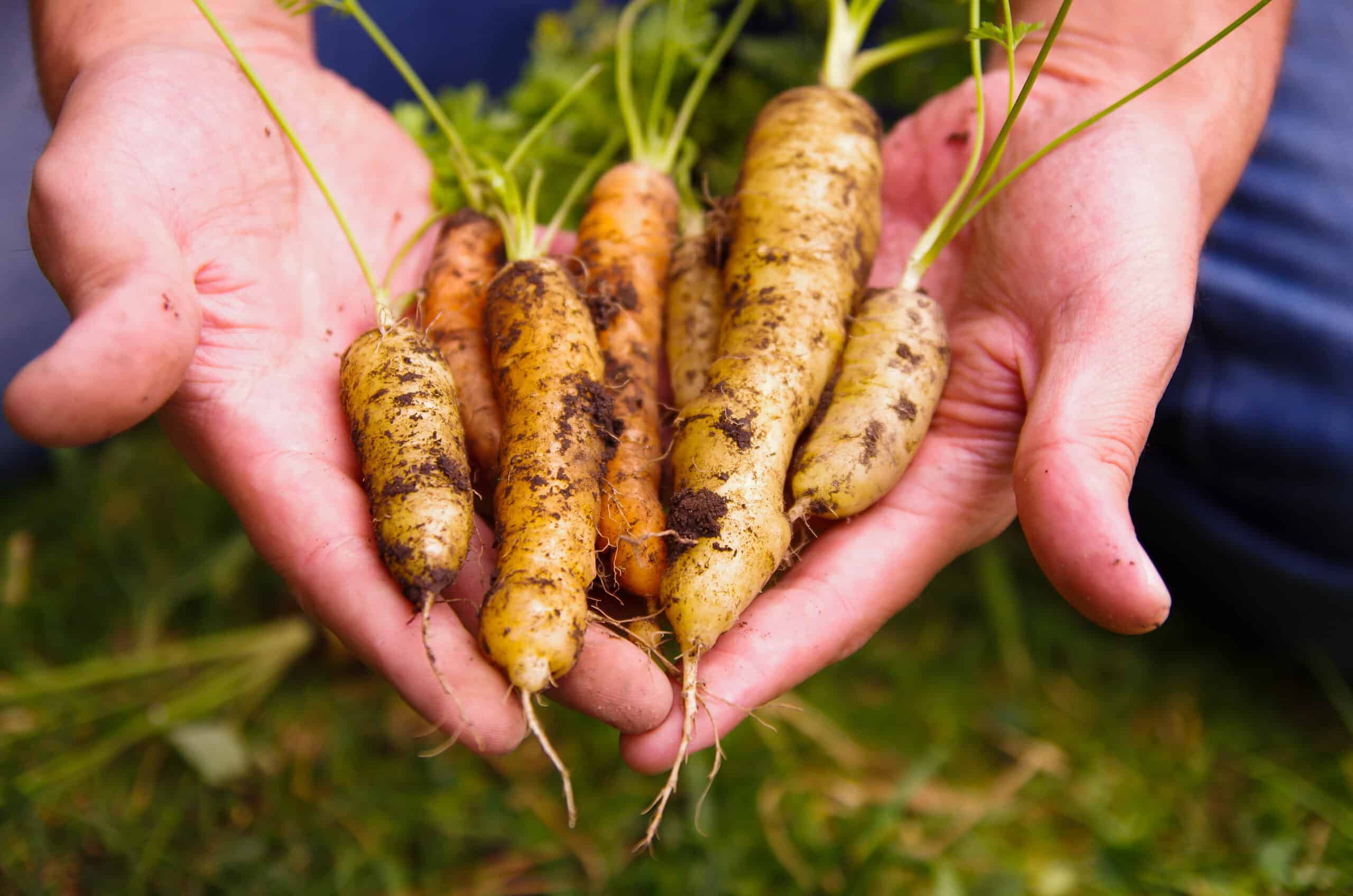
Carrot seed saving
Carrots are biennials; they will flower in their second season of growth. Leave a few plants in the garden until the second season to produce seeds. Allow plants to die and dry in place then seeds will easily shake from the plant. Carrots are insect-pollinated; carrots allowed to flower should be isolated from other varieties as well as wild relatives such as Queen Anne’s Lace to avoid cross-pollination.
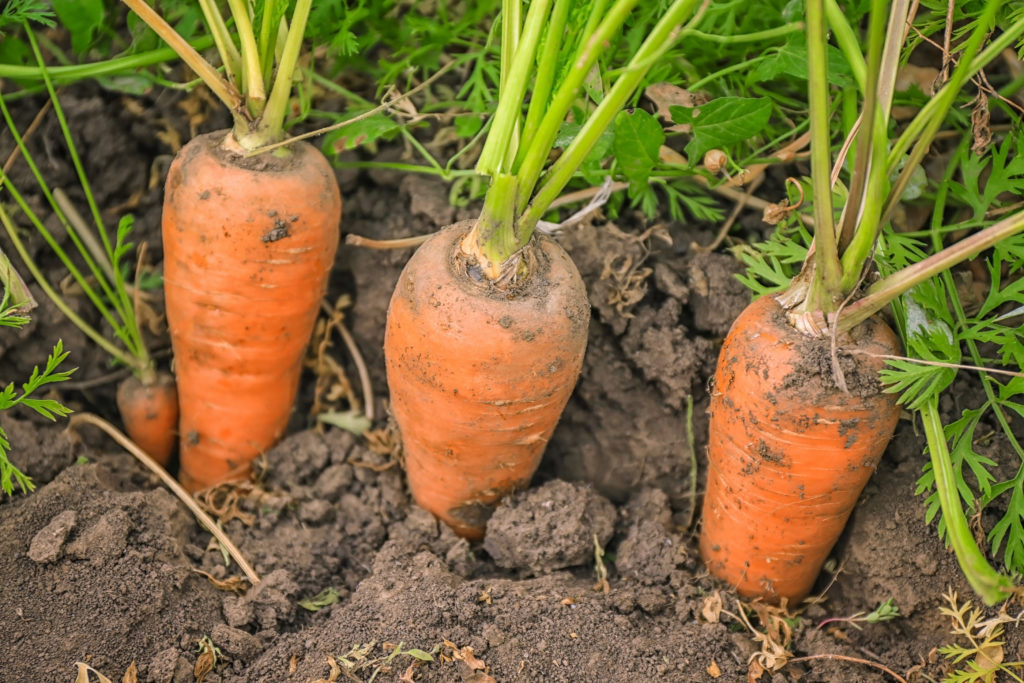
Harvesting carrots
Harvest carrots before the soil freezes or protect the soil from freezing by covering the bed in thick mulch. Heavy mulch will protect roots from rotting; roots can be pulled throughout winter whenever needed.
- Carrots can be harvested any time after they are large enough to use.
- Mature carrots will be ready for harvest 50 to 80 days after sowing depending upon the variety.
- Baby carrots can be harvested in 30 to 40 days.
- Use a trowel or garden fork to lift one or two carrots to check the size and flavor when you are ready to harvest.
- Regular main crop carrots are usually ready for lifting when they are ¾ to 1-inch (2.5cm) thick.
- Lift carrots gently by hand where the soil is loose. Where the soil is heavy, loosen the soil with a trowel or garden fork and then lift the roots gently so that they don’t break. Pull carrots when the soil is moist. Do not disturb the roots of carrots that remain in the soil.
- The last of your carrot crop should be harvested from early fall until the first frost; complete the harvest before the ground freezes.
- Where temperatures reach freezing but the ground does not freeze, cover unharvested carrots with a thick mulch to prolong the harvest for a month or more.
- Where temperatures do not drop below 20°F (-6.7°C), carrots can be left in the ground through the winter as long as they are under heavy mulch.
More harvest tips: How to Harvest and Store Carrots.
Storing carrots
- Carrots can be left in the ground until ready to use as long as the ground does not freeze.
- Carrots will keep in the refrigerator or root cellar for 1 to 3 months at about 40°F (4.4°C). It is best to remove carrot tops so that roots do not suffer moisture loss.
- Avoid storing carrots near apples which emit ethylene gas that can give carrots a bitter taste.
- Blanched carrots will keep in the freezer for up to 6 months.
Carrots kitchen use
- Serve carrots raw or cooked.
- The best carrots are young and slender. Young carrots will be crunchy carrots.
- Baby carrots are very tender but, because of their lack of maturity, not as flavorful as mature carrots.
- Remove carrot greenery as soon as possible because it draws moisture and vitamins from the root.
- Young carrots should be lightly rinsed before using; older carrots should be peeled.
- If carrots have become limp, re-crisp them in a bowl of ice water.
- Garden-fresh carrots cook more quickly than grocery store-bought ones, and smaller ones more quickly than larger ones.
- Carrots are cooked tender when a shark fork pierces the root with just a little pressure. Don’t cook carrots until they become mushy.
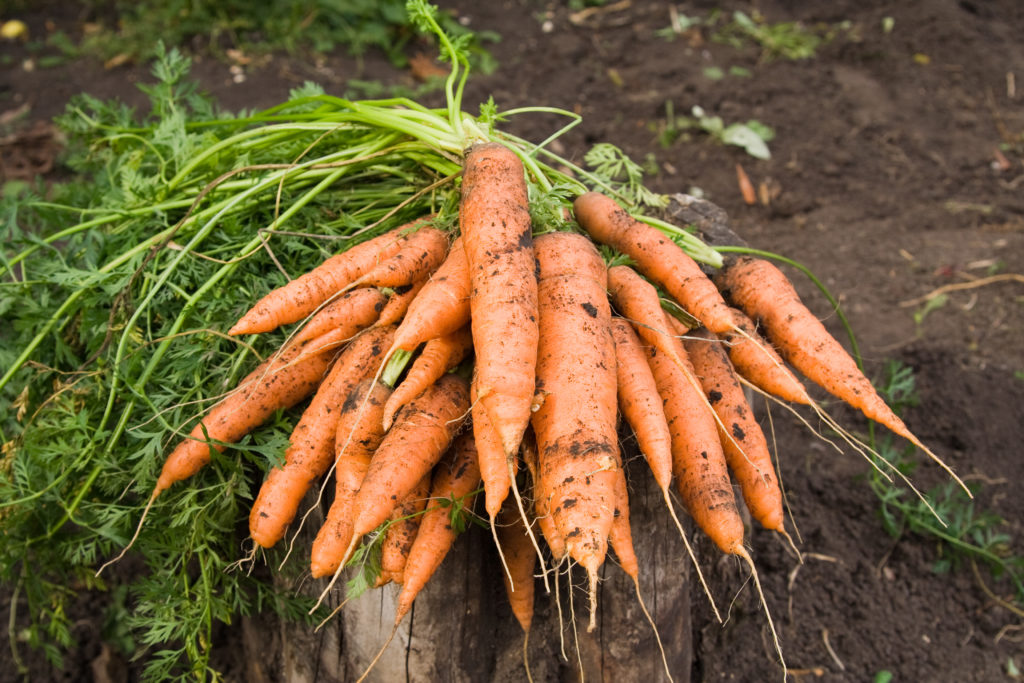
Growing carrots for flavor
Choose the carrots you want to grow by the carrot flavor you most enjoy. There are three common carrot flavor descriptors: sugary, pine-parsley, and woody.
Carrot flavor is genetically determined—some carrots will simply be sweeter than others. Growing carrots when days are warm and nights cool and growing carrots in loose, organic soil can enhance a carrot’s natural flavor—but will not make a less sweet carrot sweeter.
Some carrot varieties are more sugary, others are more parsley flavored, and others are naturally woody in taste. Commonly sweet-flavored carrots are preferred for eating out of hand. All carrots when cooked will be sweeter flavored than when eaten raw; that’s because cooking weakens a carrot’s cell walls and releases the sugars inside.
All carrots mature into their flavor. They become tastier as they grow. The taste of a carrot is driven by natural chemicals.
How carrots get their flavor
Carrot flavor and aroma are made up of sugars and terpenoids. The natural sugars—sucrose, glucose, fructose, and maltose—give carrots their sweet flavor. The organic chemicals or compounds called terpenoids give carrots their characteristic aroma.
Young carrots develop terpenoids first; these are volatile compounds, meaning they are aromatic. Terpenoids can smell like pine, wood, citrus, and turpentine. A carrot harvested too early can taste bitter and soapy.
As carrots grow, natural sugars develop through photosynthesis and are stored in the root. When days are warm and nights cool, carrots make sugar during the day but do not expend that sugar energy at night. In other words, the carrot grows sweeter. (When nights are warm–60°F/15.6°F or greater, carrots respire and burn sugar energy; sweetness is not enhanced.)
Carrots are sweetest when they mature at the time of year when the days are warm and the nights are cool. As well, the best time to harvest a carrot is at the end of a warm day as it finishes manufacturing new sugars through photosynthesis.
In the life of a carrot, terpenoids-driven taste comes first and, in time, is balanced with sugar flavors. The sweet carroty flavor is the perfect combination of terpenoids and sugars.
Harvesting carrots for flavor
You can begin to harvest carrots as soon as they are big enough to eat, but sugars concentrate as carrots mature. When a carrot reaches the peak of maturity it will be the most vibrantly colored. Depending upon the color of the carrot that may mean it will be a vibrant orange, red, yellow, purple, or white. Within two or three days of reaching full color, a carrot’s color will begin to mute and, at the same time, sugars will begin to turn to starches and in time the flavor will wane.
Cooking breaks down the terpenoids in carrots and at the same time releases natural sugars. Cooked carrots will be sweeter than raw carrots.
Sweet-tasting carrot varieties
You will find the carrots listed here sweet-flavored if harvested at or before maturity.
- Bolero: sweet, juicy, crunchy, orange to 7 inches (17cm) long; 75 days to harvest; hybrid.
- Ithaca: sweet, light taste, deep orange to 7 inches long; 65 days to harvest; hybrid.
- Little Finger: extra sweet, orange to 3½ inches long; 65 days to harvest; open-pollinated.
- Nantes Half Long: tender, sweet, fine-grained, nearly coreless, deep-orange to 6 inches (15cm) long; 65 days to harvest; open-pollinated.
- Purple Dragon: sweet, rich, purple skin, yellow core, to 6 inches long; 65 days to harvest; open-pollinated.
- Royal Chantenay: sweet, tender, reddish-orange to 6 inches (15cm) long; a good choice for heavy or shallow soils; 65 days to harvest; open-pollinated.
- Scarlet Nantes: sweet, juicy, fine-grained, coreless, orange-red to 6 inches long; 65 days to harvest; open-pollinated.
- Short ‘n Sweet: sweet, juicy, bright orange to 4 inches (10cm) long; a good choice for heavy soil; 65 days to harvest; open-pollinated.
- St. Valery: sweet, tender, little core, bright reddish-orange to 10 inches long; 70 days to harvest; open-pollinated.
- Touchon: crisp, sweet, coreless, orange to 6 inches long; 65 days to harvest; open-pollinated.
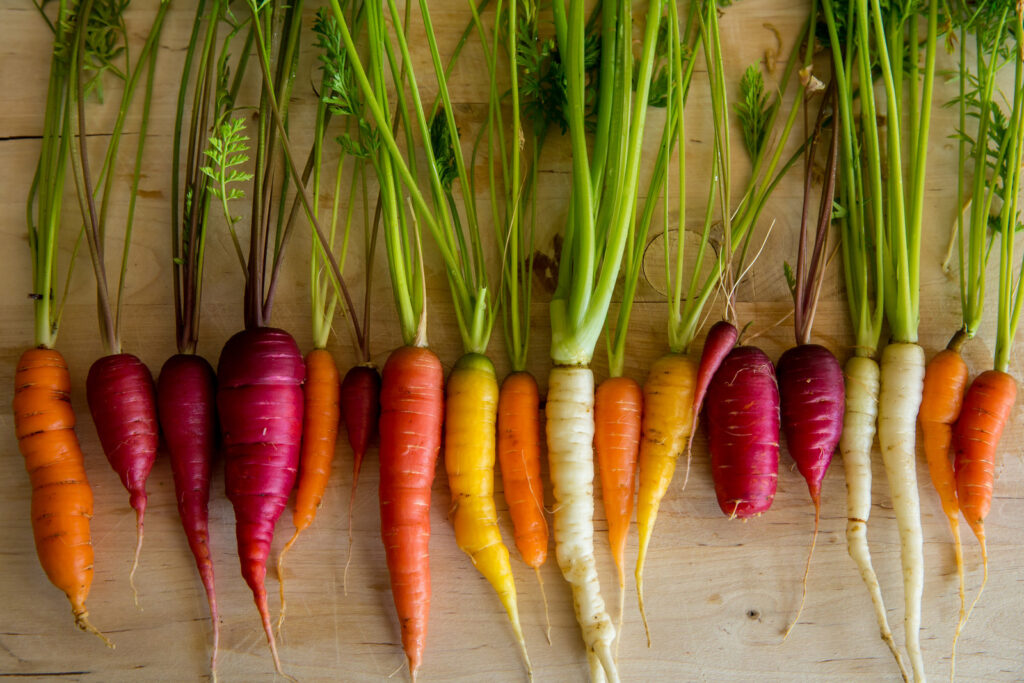
Carrot color and nutrition explained
Carrot color is determined by two groups of pigments: carotenoids, which produce red, yellow, and orange hues; and anthocyanins, which develop the color purple.
Carotenoids and anthocyanins are phytonutrients. Phytonutrients act as antioxidants that counter free radicals in the human body helping to protect against cancer and cardiovascular disease. Carotenoids include alpha- and beta-carotene which help support vision health and boost the immune system.
Carrot colors and varieties
Here’s how carrot colors are healthy:
- Orange carrots contain alpha- and beta-carotene; these pigments are converted into vitamin A which helps bolster the immune system and supports healthy vision.
- Yellow carrots contain lutein a carotenoid pigment that is believed to prevent macular degeneration, an eye disease.
- Red carrots contain lycopene, a carotenoid pigment that helps prevent prostate cancer.
- Purple carrots contain anthocyanins which help prevent cancer, heart disease, and stroke.
- White carrots are white because they lack pigment; white carrots contain beta-carotene like orange carrots (but less).
Orange carrots
- Chantenay Red Cored: golden orange skin: 5 to 7 inches long; 2 inches at the shoulder; grows well in heavy soil; resists splitting and forking: 70 days to harvest; open-pollinated.
- Danvers 126: 6 to 7 inches long and about 2 inches at the shoulder; smooth skin; very good storage carrot; resists cracking and splitting; strong tops make it easy to pull from the garden; introduced in 1947, an improved Danvers Half Long; 73 days to harvest; open-pollinated.
- Danvers Half Long: old standard American carrot dating to 1870s; 7 inches long; good flavor; adaptable and dependable; 70 days to harvest; open-pollinated.
- Imperator 58: deep-orange skin; 6 to 7 inches long tapered to the blunt point; excellent flavor when eaten raw; improved version of All-American Selection winter in 1933; original Imperator is a cross between Nantes and Chantenay; 75 days to harvest; open-pollinated.
- Kurdo Long 8: deep orange; 7 to 9 inches long; stubby cylindrical roots; mild and sweet flavor; excellent for juicing; grow well in all climates; 75 to 80 days to harvest; open-pollinated.
- Little Fingers: deep orange skin; three inches long, half-inch across at shoulders; blunt tip; smooth skin; small core; harvest young and tender as a baby gourmet carrot; 60 days to harvest; open-pollinated.
- Scarlet Nantes: bright orange; 4 to 6 inches long; slender and slightly tapered; sweet, crisp, and flavorful; first introduced in 1870; developed near Nantes, France from an old variety called Half Long Stump Rooted; 68 days to harvest; open-pollinated.
- Royal Chantenay: reddish-orange skin; 5 to 7 inches long; cylindrical with stump tip; good grower in heavy or shallow soil; good for canning, drying, or freezing; good juicing carrot; 70 days to harvest; open-pollinated.
- Tendersweet: rich orange, smooth skin; 6 inches long; cylindrical; sweet, tender, and nearly coreless; a good choice for cooking, canning, pickling, baking, and juicing; heirloom variety; 75 days to harvest; open-pollinated.
Yellow carrots
- Amarillo Yellow: pale lemon-yellow root; bright yellow flesh; 8 inches long; mild flavor; crunchy and juicy; 75 days to harvest; open-pollinated.
- Jaune De Doub: yellow to light orange skin; conical root; strong sturdy stems easy to pull from the garden; heirloom dates from 16th century Europe; good storage carrot; 63 days to harvest; open-pollinated.
- Solar Yellow: buttery yellow flesh; 6 to 7 inches long; sweet and crisp; Danvers-type heirloom dating to 900s; 60 days to harvest; open-pollinated.
Red carrots
- Atomic Red: brilliant red skin; 8 inches long; crisp and flavorful; best cooked; color deepens with cooking; heirloom; 75 days to harvest; open-pollinated.
- Nutri-Red: salmon-red skin; 9 inches long; slim root; Imperator type; robust carrot flavor; color intensifies with cooking; 70 days to harvest; open-pollinated.
- St. Valery (also called James Scarlet): bright orange-red skin; 10 to 12 inches long; sweet and tender; dates to 1885 in France; 80 to 90 days to harvest; open-pollinated.
Purple carrots
- Cosmic Purple: purple skin with deep orange flesh; 6 to 7 inches long; sweet flavor; crunchy; released in 2005; developed from old heirloom60 days to harvest; open-pollinated.
- Dragon: vivid purple skin with bright orange flesh; 6 to 8 inches long; a smokey flavor that can be bitter raw but is spicy and delicious cooked; 80 days to harvest; open-pollinated.
White carrots
- Lunar White: creamy-white skin; 6 to 8 inches long; small core; mild, delicious flavor; heirloom originated in Northern Europe in the 1600s; 65 to 75 days to harvest; open-pollinated.
- Snow White: creamy-white skin; 7 to 8 inches long; mild-sweet flavor with crunch; good raw or cooked; 75 days to harvest; open-pollinated.
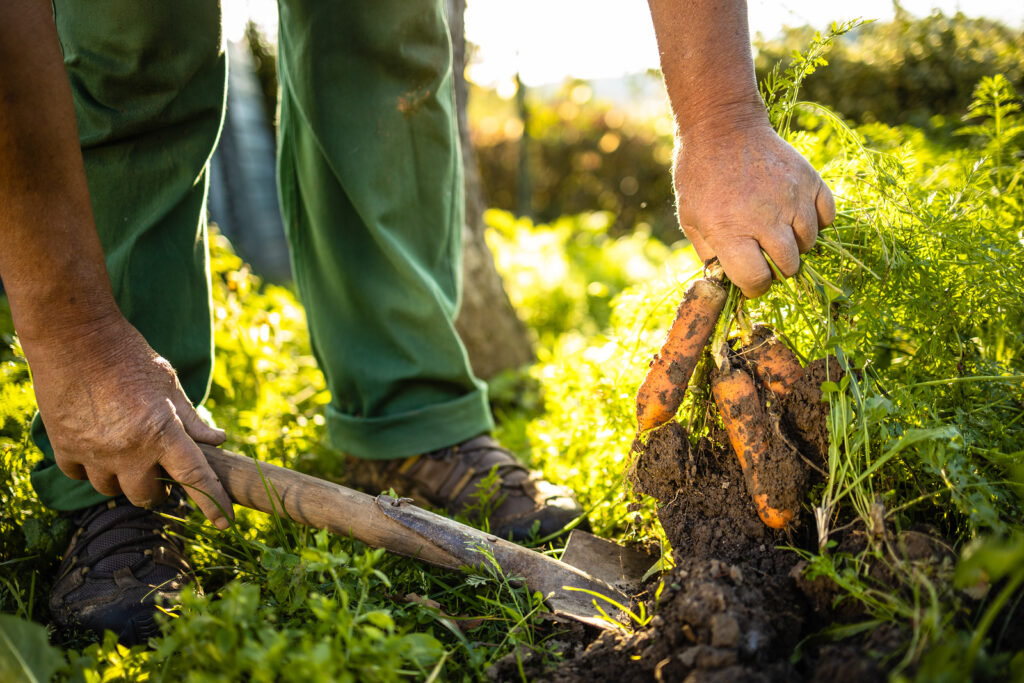
Nantes carrots
The Nantes carrot was first described in a nineteenth-century French vegetable seed catalog in this way: “Root almost perfectly cylindrical…skin very smooth…flesh of the root entirely red, very sweet and mild in flavor….”
The Nantes carrot takes its name from the city on the Atlantic coast of France where the surrounding countryside is ideal for its cultivation. (“It only attains its full quality in a mellow, deep soil…,” wrote Henri Vilmorin in the 1885 edition of his family’s seed catalog.)
Shortly after its introduction, the Nantes became a kitchen garden favorite and its reputation (and cultivation) rightfully spread far and wide.
Today there are more than a half dozen varieties of carrots that specifically bear the Nantes name, but more generally Nantes has come to embody a quite large (more than 40 members) class of medium-sized cylindrical carrots rounded at both the top and tip. In general, Nantes cultivars are known for being sweeter and tenderer than other carrots.
Carrots frequently asked questions
Q: When can I begin planting carrots?
A: Begin direct sowing carrots in the garden two weeks before the last spring frost. Succession plant carrots every two weeks throughout the season until sixty days before the first killing frost. In mild-winter regions, you can sow carrot seeds all year long, as long as raise don’t wash seeds away before they sprout.
Q: Why do some gardeners plant carrot and radish seeds together?
A: Radish seeds take only a few days to germinate, so they will come up and mark carrot rows for you while gently loosening the soil around the carrots to give them a good start. Harvest radishes as soon as they are mature; this will allow carrots to mature in loose soil. Sow radish seeds at a ratio of about one radish seed to nine carrot seeds.
Q: I have tried growing carrots, but my soil is heavy and carrots are always crooked. Any suggestions?
A: Try growing short, stubby, or even round varieties. These don’t grow deep into the soil so they are less likely to twist or fork and they are easy to harvest. You can also dig a trench and fill it with lighter soil, or build up a raised bed of lighter soil. This will allow you to grow carrots with a straight, long root.
Q: Do carrots need watering and fertilizing?
A: Keep the soil moist until carrots sprout, then water infrequently but deeply. The roots will follow the moisture down. Carrots are not heavy feeders and should not be over-fertilized. Too much nitrogen will produce lots of foliage but not very good roots. Fresh, uncomposted manure will cause the root to be hairy and to fork.
Q: When is the time to start harvesting carrots?
A: Baby carrots and thinning are usually ready in about 40 days. Carrots that are about finger thickness will be sweet and have the best flavor. Thin carrots to about 2 inches apart to let them reach mature size.
About carrots
- Carrots are hardy biennials grown as annuals.
- The carrot plant has a rosette of finely divided fernlike leaves that grows from a swollen fleshy taproot which can vary in size, shape, and color. Carrot foliage is rather bristly, much-divided, or compound leaves. Carrot flowers are very small, in a flat-topped cluster (umbel), below which is a whorl of leaf-like bracts.
- Depending upon variety, carrots can be tapered and cylindrical, short and fat, round, or finger-sized.
- Some carrots grow to 10 inches (25cm) long; others are much shorter.
- Carrots are usually orange, but colors can vary from red to yellow to purple.
- Shorter varieties are a good choice for heavy soil; long types require loose, loamy soil.
- Botanical name: Daucus carota
- Family: Apiaceae (Umbelliferae); this family includes celery, parsley, parsnip, dill, caraway, and anise
- Origin: Europe, Central Asia
Carrot articles at Harvest to Table:
Grow Carrots Any Time of the Year in Five Steps
How to Harvest and Store Carrots
Carrot and Parsnip Growing Problems: Troubleshooting
Seven Ways to Cook and Serve Carrots
Baby Beets, Baby Carrots, and Snap Peas Salad
More how to grow articles:
Learn how to plant, grow, and harvest your favorite vegetables. Click below for all you need to know.
- Artichoke
- Arugula
- Asparagus
- Beans, Snap
- Beets
- Broad Beans
- Broccoli
- Brussels Sprouts
- Cabbage
- Cantaloupe — Melons
- Cardoon
- Carrots
- Cauliflower
- Celeriac
- Celery
- Chard
- Chayote Squash
- Chickpeas
- Chicory
- Chinese Cabbage
- Collards
- Corn Salad
- Corn, Sweet
- Cresses
- Cucumbers
- Eggplant
- Endive and Escarole
- Fava Beans
- Florence Fennel
- Garbanzo Beans
- Garlic
- Horseradish
- Jerusalem Artichoke
- Kale
- Kohlrabi
- Leeks
- Lettuce
- Lima Beans
- Melons
- Mizuna
- Mustard Greens
- New Zealand Spinach
- Okra
- Onions
- Parsnips
- Peanuts
- Peas
- Peppers
- Potatoes
- Pumpkins
- Radicchio
- Radishes
- Rhubarb
- Rutabaga
- Salsify
- Shallots
- Sorrel
- Southern Peas
- Soybeans
- Spinach
- Squash, Summer
- Squash, Winter
- Sunchokes
- Sweet Potato
- Swiss Chard
- Taro
- Tomatillo
- Tomatoes
- Turnips
- Watermelon
- Zucchini
Grow 80 vegetables: KITCHEN GARDEN GROWERS’ GUIDE
Garden Planning Books at Amazon:
- Vegetable Garden Grower’s Guide
- Tomato Grower’s Answer Book
- Vegetable Garden Almanac & Planner
- Kitchen Garden Grower’s Guide Vegetable Encyclopedia















